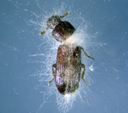Red Flour Beetle
Tribolium castaneum
Classification
- Phylum: Arthropoda
- Subphylum: Hexapoda
- Class: Insecta
- Order: Coleoptera
- Suborder: Polyphaga
- Superfamily: Tenebrionoidea
- Family: Tenebrionidae
- Subfamily: Tenebrioninae
- Tribe: Triboliini
- Genus: Tribolium
- Species: castaneum
Pronunciation
How to pronounce Tribolium castaneum: /traɪˈboʊliəm kæˈstæniəm/
These audio files are automatically generated. While they are not always 100% accurate, they are a good starting point.
Images






Summary
Tribolium castaneum, or the red flour beetle, is a small beetle species in the family Tenebrionidae, widely recognized as a pest of stored food products. It exhibits polyandrous behavior and is significant in research as a model organism.
Physical Characteristics
Adults are small, around 3–4 mm long with a uniform rust, brown, or black color. The head and pronotum are sometimes darker than the rest of the body.
Habitat
Commonly found in warm and often dry conditions, particularly in granaries, flour mills, and feed mills. These beetles are also frequently found in imported produce on cargo ships.
Distribution
Widely distributed, most common in the southwestern United States but originally of Indo-Australian origin. Now cosmopolitan but more common in warmer regions; prevalent throughout the Prairie Provinces in Canada.
Diet
Secondary pest of a wide range of cereals, cereal products, legumes, oilseeds and cakes, nuts, spices, and animal products. Prefers damaged grain but can attack sound grain, especially with high moisture content.
Life Cycle
The adult is long-lived, sometimes living more than three years. Although previously regarded as relatively sedentary, research shows considerable dispersal by flight.
Reproduction
Females exhibit polyandrous mating behavior, mating with multiple males during a single copulation period. Male competition and sperm removal dynamics affect fertilization success.
Ecosystem Role
Red flour beetles are pests of stored food products, causing significant loss and damage. They play an important role in food safety research and the study of entomology.
Economic Impact
Major pests in stored products, particularly affecting food grains, leading to economic damage in food storage sectors.
Cultural Significance
Red flour beetles are essential in food safety research and agricultural practices, serving as model organisms in various genetic and ecological studies.
Collecting Methods
- Trapping
- Sampling from infested food stores
Preservation Methods
- Drying
- Preserving in ethanol
- Freezing
Similar Taxa
Tags
- Red Flour Beetle
- Tribolium castaneum
- Pest
- Food Safety
- Model Organism